Creating Childcare Environments
- Technique 01: How to capture childcare environments--examples of Japan and Sweden
- Technique 02: Building a broad personal network through the creation of childcare environments (This article)
- Technique 03: Technique to change childcare environments
- Technique 04: The value of outdoor environments in Denmark
- Technique 05: Fostering children's emotional development in childcare environments by providing "real things"
- Technique 06: How to understand the meaning and value of the shape of things through the construction of custom-made childcare facilities--Example of a German kindergarten
I am conducting a workshop with childcare facility teachers based on my experience participating in the fields of architecture and urban planning. The discussion topics are: (A) "What kind of building it is that we want" when designing a childcare facility; (B) "How to make best use of the building" after completing the construction; or (C) re-consider the childcare environment or discuss "How we want the children to be, once the rearrangement of the facility rooms is complete." In this way, we thoroughly discuss the connective meanings of the keywords that emerge during the workshop.
Let's hold a workshop and harness our feelings in one direction!
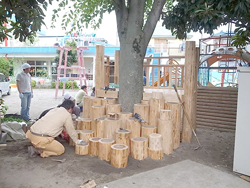 |
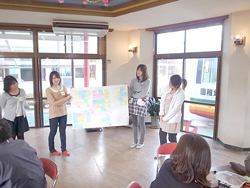 |
|
| Figure 1: The "Cicada-Catcher" made by fathers (left) Figure 2: A group presentation at the workshop with teachers (right) |
||
| (Both photos in Figures 1 and 2 were taken at Kawagoe Lumbini Kindergarten) | ||
A workshop has the power to unite the participants in such a way to determine what they make and why. As an example, I will tell you about the "Cicada-Catcher," which was made together with a group of fathers. This event was prompted by the request "Please design a new piece of playground equipment for our playground, to replace the rusted iron climbing frame". In response, I hosted a workshop with kindergarten teachers to discuss the notion of an ideal playground for children (Figure 2). If we had not held this workshop, we would not have come up with the idea to create a "Cicada-Catcher."
Draw out opinions and shape our feelings
A workshop needs only a desk, some chairs, some paper, and a number of participants (Figures 3 and 4). The key point is to get into small groups according to the places for which you want to make suggestions for renovation (e.g., each room or the playground). Most people feel more comfortable speaking out within a small group of five or six people, compared with speaking in front of a large audience (Figure 3). At this stage, I would ask some outsiders to participate in these small groups for discussion. These might be the members of my laboratory, refurbishment contractors, or even parents, who have no knowledge concerning the circumstances of the facility. By doing so, teachers need to explain the situation to outsiders, which will help them get their thoughts into shape and finalize the reason for and desired objective in changing the childcare environment.
When each group forms a decisive opinion, it is important to share it within the group (Figure 4). It would be advisable to use a floor plan with faint projection lines (as explained in "Technique 01") when discussing the environment of childcare rooms. By using a floor plan, we can objectively visualize the whole picture and all participants can get a firm grasp of the actual environment, which will help us gain a sense of scale and become specialists in childcare environments.
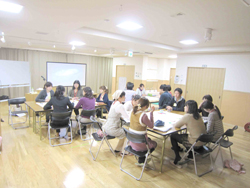 |
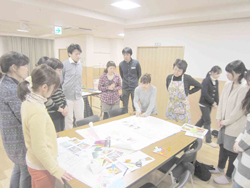 |
|
| Figure 3: A workshop held in small groups for discussion (left) Figure 4: A group presentation to communicate and share the thoughts of each group (right) |
||
| (Both photos in Figures 3 and 4 were taken at Minami-Oizumi Niji-no-iro Daycare Center) | ||
Childcare environment through the eyes of children
It is also important to consider childcare environments from the viewpoint of children. Figure 5 shows something I found in a Swedish Förskola (a preschool facility in Sweden). Several photographs showing different types of indoor play (in each corner) were displayed on the door, and children voted for their most favorite type by clipping a peg with their name on it to the particular photograph. When I interviewed the teachers at the facility, they said they were trying this system to identify topics for discussion among them. When we ask for children's opinions on childcare environments, it is easier to enquire about their most and least favorite places. Sometimes we discover that the place that we expected children would probably like best was actually not their favorite. For example, a child aged five years who was asked to draw a picture to introduce his childcare facility described the entire picture of the facility that reflected his unique perspective (Figure 6).
I have been conducting research on childcare environments up to the present day, and gradually came to realize that the more diverse an environment we can provide, the wider a variety of ideas we can extract from the children's responses.
We have previously conducted a "Sound Quiz" for children to figure out how children recognize their childcare environment through sounds. In this Quiz, we asked each child to listen to certain sounds collected within the facility for ten seconds and then say what they thought the sounds were. Children did not identify the actual source of the sound but said things like "This is the sound I hear when I play with XX (another child) using XX." Children remember the sounds together with their activities and peers through their experience, and as a result, describe these sounds mentioning the names of their peers and activities. For example, when I gave them the sound of wind chimes hung near a swimming pool in autumn, they talked about their experiences of playing in water in summer. In this way, we verified the effects of the childcare environment, which was created at the facility to promote emotional development in young children (Note 1).
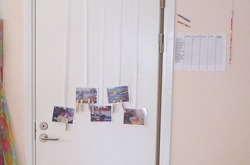 |
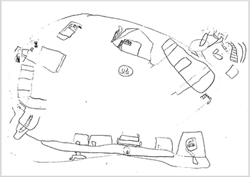 |
|
| Figure 5: Photographs on the door with children's pegs to show their vote (left) Figure 6: A child's drawing of the entire daycare center, looking down on the playground (right) |
||
| (Wako Daycare Center: reported by Shiori Yamaoka at the Sato laboratory) | ||
A diversified personal network through the creation of childcare environment
The meaning and value involved in creating childcare environments may vary when different people take part. In the case of Figure 1, the fact that "their fathers created" the Cicada- Catcher rather than "teachers who they don't even know" makes the children more motivated to catch cicadas using the tool and have more affection for it. Moreover, the fathers, who came to drop off and pick up their children, also watched how the Cicada-Catcher was being used, and showed interest and passion for their children's childcare environment. Through this event, fathers started to socialize more through convivial drinking gatherings. The process of creating childcare environments provides opportunities for various people including parents to get involved.
Figure 7 shows a workshop for fathers making playground chairs. Fathers were invited to the workshop titled "Daddy! Please make a chair!" The event was also considered to be a workshop for fathers given by a professional furniture craftsman. Again, a community of these fathers was created. The issue is, the first workshop might require a little ingenuity to invite reticent fathers. We need to effectively convey a message to fathers that their children want them to make chairs and that creating such chairs with other fathers should be a fun activity. As a matter of fact, in the case of Figure 1, I presented an amusing slide show to invite fathers to their visiting day, following the call-for presentation by the facility.
As a physical environment is visible, it is easy to create a relatively attractive one by investing some money. However, if we can pull out and shape the above mentioned feelings from the children and parents such as "we want it and want to make it" or "we need to make it" and have them enjoy the process of creating the childcare environment, it naturally leads to creating a more significant environment for each facility.
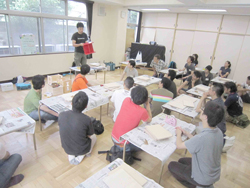 |
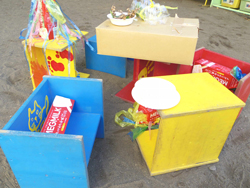 |
|
| Figure 7: A workshop for making chairs for the playground hosted on a Saturday at a public daycare center (cooperation: Mr. Akira Aizawa) (left) Figure 8: Handmade chairs used in the playground in various ways. The chair can be used as a small table by turning it over. (right) |
||
| (Both photos in Figures 7 and 8 were taken at Shinagawa Koyamadai Daycare Center) | ||
Note 1: "Study on children's recognition of sound environments at childcare facilities" written by Masayuki Sato, Saki Noguchi, and Masashiro Wakamori, p.102, No.1, Vol.6 of "Child, Youth and Environmental Studies", 2010



 Masayuki Sato, Associate Professor, Department of Human Behavior and Environment Sciences, Waseda University
Masayuki Sato, Associate Professor, Department of Human Behavior and Environment Sciences, Waseda University










